#Jewish Museum uniform
Text
ZONE OF INTEREST (2023)

This is a deeply unsettling movie about the Nazi commander and his family who ran the Auschwitz concentration camp during World War II.
There isn’t much plot. We simply follow the family as they live their daily lives on the edge of the camp of horror. The wife receives a delivery: clothes stolen from newly-arrived prisoners, which she invites her household staff to share. The wife takes for herself a fur coat. She tells a servant to have it cleaned and mended. Her husband, based on the real life person who perfected the machinery of mass murder, named Hoss, receives visitors with plans for improved incinerators. The wife tends to her garden, and they have dinner at night as a family. The only intrusion of the camp is auditory: there is an ever-present rumbling, at times punctuated by gunshots. One can look from the garden toward the smokestacks of the incinerators spewing ash into the air.

The wife’s mother comes to visit. The mother looks out the window at night at the glowing incinerators. She leaves without telling her daughter. The wife, pissed, threatens a slave with incineration. Hoss sexually assaults a slave and furtively cleans his genitals in a basement sink. He is transferred to another post, but his wife doesn’t want to leave. “This is our Lebensraum,” she says, pointing to the house. Hoss attends a meeting where men in uniforms and suits plan the destruction of Hungary’s Jewish population. Hoss is transferred back to Auschwitz, but beforehand he attends a party. Later he calls his wife and explains that he spent the time thinking about how to most efficiently kill everyone there.
He leaves the office at night but stops to vomit in the stairwell. He pauses on a landing and looks in our direction. There is a hard cut and we are at Auschwitz, now, as employees clean the museum. They sweep and vacuum the floors. They clean the glass displays, behind which are the shoes and clothes of the dead. We cut back to Hoss, who descends the stairs into darkness.

This is existential horror. We don’t have to wonder if people could ever commit industrial-scale murder, because they already have. We view the perpetrators here with detachment. Shots are framed with wide-angle lenses. One of the only close-up shots is of Hoss at work, focusing in on his face as he looks at something off screen and we hear terrors around him. The only other close-up we get is of a nameless Polish girl. We see her twice throughout the movie as she sneaks across the landscape, hiding food for the slaves of the camp, before returning home. She’s presented in reverse colors, like a film negative, the moral opposite of those running the camp.
This film is not especially enjoyable to watch, yet it is a work of art.
44 notes
·
View notes
Text
grandma why
When I Worked At The Museum (news at eleven), an older woman was leading her little grandson around the European galleries. The child is extremely interested in all of the paintings, asking very spirited questions. What's this one about? What's THIS one about? The grandmother is happily answering them, and when she doesn't know, she checks the wall labels and relays her findings.
Then she gets to The Rape of Tamar.
"What's this one about?" asks the boy, eagerly. There's already a knife involved in this painting. He doesn't need to know the very, very awful Old Testament details. The grandmother looks very, very panicked.
"Uh, he's doing a bad thing," she says, and quickly moves on.
Nice save, I think, admiring the dodge.
They get to the wall I'm leaned against.
"What's this one about?" asks the boy, very happily distracted by the 10 foot painting on the opposite wall.
It's a painting of Christ and his Apostles. It's by El Greco, and it's huge. The grandmother, already exhausted from nearly having to explain incestuous sexual assault to a seven year old, turns to me and has an idea.
"Why don't you ask her?"
The boy looks up at me and my uniform. I look back much like a deer in the headlights.
"What's this one about?" asks the boy, excited.
It's not a question of whether or not I know. I do know what it's about. I've taken art history classes in college. I've read the wall labels. No, my issue is this:
I do not know the denomination of the kid, whether he even has
I do not know the denomination of the grandmother, whether she even has one
I am very, very Jewish
I will make no assumptions but
HOW DO I EXPLAIN ANYTHING ABOUT CHRIST IN A WAY THAT'S SECULAR BUT NON-OFFENSIVE.
"So, Christ was someone who was magic, and he collected lots of magic friends, and they went around solving a lot of problems for people, and sometimes they saw the future -- and this is one about them seeing the future--"
The kid found it cool, so I think I managed.
Sorry you nearly had to explain the Rape of Tamar to a seven year old, ma'am.
EPILOGUE:
Also overheard in the same galleries:
"Dad, what's a Virgin?"
"Ahahahaha what's a virgin....um"
20 notes
·
View notes
Text

This was left anonymously on the door of a person I know, a person of color. It was left yesterday at their home just north of Tampa, Florida for their kids to see. These is from a Ron DeSantis supporter. Neo-Nazis openly support DeSantis. They follow him to all his events dressed in Nazi S.S. uniforms waving Nazi swastika flags and carrying placards with nasty comments about Jews, POC, and immigrants. They also hold rallies and march publicly often waving Nazis flags from highway overpasses and in front of the entrance to Disney. They picket events held by the LGBT community, Jewish groups, immigrant groups, and Democratic groups. Often they brandish guns to intimidate the people they are picketing. DeSantis has been asked many times by public figures and members of the press to denounce these Nazis, often on tape. DeSatan publicly refuses to denounce the Nazis or any other alt-right group.
There is a Holocaust museum in St Petersburg just south of Tampa. It is a heartbreaking place to visit. Inside is a rail car that brought Jews and others to concentration camps. It is riddled with bullet holes from the guards who would blindly fire into it if its occupants became noisy. The museum has armed guards and metal detectors.
The more this hits home for me, the more I will resist. I will show them nothing but contempt online and in person.
YOU CAN NOT TAKE THE HIGH ROAD WITH NAZIS. THEIR PURPOSE IS TO ELIMINATE US.
67 notes
·
View notes
Text
The photograph below of the 1945 Shavuot prayer service in the liberated Buchenwald camp hangs in Yad Vashem’s Holocaust History Museum. Leading the service is Rabbi Herschel Schacter, a Jewish chaplain who was among the American liberators of Buchenwald.
Upon arriving at Buchenwald, the young Rabbi realized these prisoners were frightened of his uniform, which for them had been a symbol of oppression, he shouted out to them in Yiddish: “Yidden, ihr zeit frei–Jews, you are free!”
Outside the barracks, Rabbi Schacter was appalled by the horrific sights he encountered. His shock and dismay grew as he discovered piles of corpses awaiting cremation, and the deplorable state of physical and mental health among the surviving prisoners.
It was there that he encountered an 8-year-old survivor, ‘Lulek’ Lau, who warily watched the Rabbi from behind the tangled bodies of the dead. Rabbi Schacter picked up the little boy in his arms, and asked him how old he was.
“I’m certainly older than you” the young boy replied.
“Older than me?” asked Rabbi Schacter, startled… “What makes you think so?”
“Because you cry and laugh as a child, while I have forgotten how to laugh, and I can’t even cry... So tell me, which of us is older?” ‘Lulek’ responded.
Rabbi Schacter stayed in the liberated camp to aid in the physical and mental recovery of the living prisoners and to renew Jewish life and traditions, including celebrating the impending Jewish holiday of Shavuot. Seated in the front row of the Shavuot prayers was 8-year-old ‘Lulek’ Lau (pictured below).
One month later ‘Lulek’ immigrated to the land of Israel. He would grow up to become the Chief Rabbi of Israel, Chairman of the Yad Vashem Council, and a leading voice for Holocaust remembrance and education worldwide: Rabbi Israel Meir Lau.

Grandchildren of Holocaust Survivors
21 notes
·
View notes
Text
Modernism & Fascism

Who’s Afraid of Red, Yellow, and Blue III 1967-1968
This painting is circling my Twitter FYP page in a meme about human-created art vs AI art.
Who’s Afraid of Red, Yellow, and Blue
The artist, Barnett Newman (1905-1970), is one of the foremost color field painters. Newman saw his work as a reaction to the horrors of World War II. “For Newman, figuring out what an artist could do after witnessing events such as the Holocaust and the bombings of Hiroshima and Nagasaki required ignoring all of art history, quote, “to start from scratch, to paint as if painting never existed before.”
In 1967 Newman finished his largest painting, Who’s Afraid of Red, Yellow, and Blue III. It shocked audiences at the time, who wrote letters to express their disgust and dismay. In the 1980s, a disgruntled painter named Gerard Jan van Bladeren slashed the painting with a box cutter. One of the main arguments the lawyer made in his defense was that the painting was a kind of cultural provocation, which called for a reaction. He was sentenced five months in prison, and people sent letters to the museum praising him, one even saying “this so-called vandal should be made the director of modern museums.”
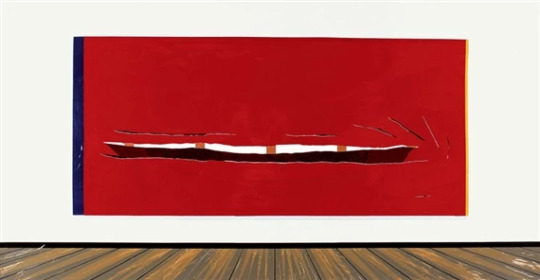
Who’s Afraid of Red, Yellow, and Blue After the Attack (2006) Thomas Raat
“Anybody Can Do That”
The museum tried to restore the painting, but no one would take them up on the job. Eventually, Daniel Goldreyer said he could repair the painting. Four and a half years later the painting was revealed. It seems like it would be easy to repair the red part of the piece, but when it was revealed people immediately noticed the red paint looked different. Previously there had been a shimmering quality to the red that gave it a sense of depth, but the restoration had a flat-looking paint that, according to critics of the restoration, robbed it of its original power.
The biggest challenge to repairing Red, Yellow, and Blue III was the simplicity of the art. Regardless of how you feel about this painting, there is an undeniable truth about the craftsmanship. Usually, texture and brushwork can mask repair work, but Newman’s work is a swath of uniform color. No visible brush strokes, no uneven texture. Anyone who has worked with paint, especially oil paint, knows how particularly difficult this is to do The recreation tried, and failed, to recreate the delicate techniques of the original.
The painting was sent to a forensic lab, and it was revealed the paint Goldreyer used would be impossible to remove. The painting was destroyed a second time.

Cathedra (1951) Barnett Newman
In 1997, Bladeren returned to the museum in search of the botched restoration. When he couldn’t find Red, Yellow and Blue III, he found another painting by Newman titled Cathedra, and attacked it with a box cutter. He also scattered a packet of pamphlets to the floor that contained incoherent writing. At his second trial, Bladeren was declared mentally unfit and sent to a psychiatric institution.
You don’t have to like Newman, but this work has incredible technical skill.
But as Jacob Geller says in the youtube video essay “Who’s Afraid of Modern art” says, the debate around whether or not the art requires technical skill misses the point. “Reducing art to a linear connection between ‘skill’ and ‘value’ fundamentally just turns art into a commodity.”
Rejection of Modern Art is a form of Fascism
Newman was a Jewish artist, and Who’s Afraid of Red, Yellow, and Blue III was struck and spat upon in Germany because the attacker said it bore a mocking resemblance to the German flag.
In 2018, another sculpture by Newman, Broken Obelisk, was vandalized by white supremacists. White paint was poured into the reflective pool, and scattered around were posters with the phrase "it's ok to be white."
It was vandalized similarly before, with swastikas spray-painted across it.

Broken Obelisk (1963-1967) Barnett Newman
You’re not a bad person if you hate modern art, or any art created after 1800. Art is a subjective experience.
Part of the problem is also how modern art museums display artwork. When art gallery patrons are given more detailed descriptions of art, they experience more positive and fewer negative emotions.
But there is a pursuit of fascism to make everything of a specific aesthetic through rigid, culturally appropriate standards. As a nation’s mythology is built on its art, the subsequent art begins to feed into this narrative by continuously referencing this mythology. The result of this self-referential loop is a hierarchy that rejects anything new or divergent from the aesthetic. Thus, when art deviates from the established norms, it doesn’t feed into that nation’s mythology, eliciting criticism. This is because it doesn’t “contribute” to that society, but challenges it." (source)

The Nazi party seized 15,000 pieces of artwork, and in 1937 selected 640 of these pieces to be displayed in a derisive exhibition called "Degenerate Art." They wanted to invite public displays of anger and protest. This art was hung crookedly under mocking slogans like "nature as seen by sick minds.” Others were displayed with the extravagant price the original work sold for, to invite mockery and derision.
This pushed the Nazi's paradigm of what constituted good vs bad art.The argument made against this artwork was that these pieces showed no sign of craft that 'real art' does, so to celebrate them is an offense to the German people and their culture.
The fact that these pieces were held in high regard was seen by Nazis as proof of the insidious plots of the left. The art held critiques of sexual norms and norms of the family values that were important to Nazi respectability. Modern art, they said ,was made for “eradication of the last vestiges of racial consciousness.” New and transgressive styles by black and Jewish artists were indicative of their ‘degenerate intellectualism.” This is eugenics through the systematic devaluation of art. (paraphrased from here)
"Modern Art" is still used as a catch-all term to denigrate any work that ignores or rejects traditional Western standards of art and beauty, and the criticisms against modern and contemporary art are not dissimilar to the arguments made by Nazis against degenerate artwork.
"What “modern art” does, directly or indirectly, is question what constitutes ‘proper art’. The idea that Rembrandt and Shakespeare are the only valid forms of artistic expression lies directly in those artists being Christian, western Europeans. By widening the frame, by hanging a Picasso, Newman, or a Van Gogh under the same roof as a Friedrich, you visualize the idea that certain ideas are not superior. The privileges of aristocratic, white Europeans are directly threatened by the mere existence of “modern art”, which makes it a target." (source)
Here is a really fantastic article about the artist as cultural worker. Culture needs to be maintained. And art that doesn’t fit into a cultural narrative becomes a target. The rejection of non-traditional art is often a rejection of oppressed people.
Fascists didn’t vandalize “Broken Obelisk” because of its simplicity, they did it to assert power and control. The criticisms of the art are just a way to assert their own “superiority” by dehumanizing the other.
20 notes
·
View notes
Text
resistance during the holocaust
As the Jewish People have been constantly discriminated against throughout history, they have worked hard to regain a sense of community, unity, and strength that can last through the generations. The Nazi Party redefined what antisemitism was, as they created a complex and calculated government-backed strategy to dehumanize the Jews. Exhibits in Yad Vashem explored the Nazi propaganda used to spread the message that Jews were not a religious group, but an evil race struggling for world domination. While the Nazi Party tortured and killed much of the European Jewish population for years, others were fighting for their lives within the ghettos and camps, and survived. The Ghetto Fighters Museum examined how people in the Warsaw Ghetto survived, along with how survivors worked hard to reestablish a Jewish community. The dehumanization of the Nazi party led to a catastrophe against the Jewish population, although through perseverance, the Jews were able to survive, and continue spreading Jewish ideology l’dor v’dor.
After the passing of the Enabling Act of 1933, Adolf Hitler began isolating Jews from society through propaganda, boycotts, and the Nuremberg Laws, as the government was not only condemning but legalizing antisemitism throughout Germany. After Germany initiated World War 2 by invading Poland in 1939, they almost immediately began establishing numerous Death Camps and Concentration Camps throughout German-occupied Europe, along with Ghettos to segregate the Jewish communities “temporarily” from the non-Jewish population. As they were forced out of their homes and placed into a small walled-in Ghetto with up to 400,000 people, their individuality was left behind as their property was seized by the Nazis. The Ghetto Fighters Museum had numerous exhibits displaying the horrific conditions inside the Warsaw Ghetto, including overcrowding and starvation. The forced labor and food ration of 180 calories a day led to an extremely high mortality rate within the ghetto. The Nazi’s brutal consequences often ended up in public executions within the Ghetto, but many of the bodies on the street belonged to inhabitants that perished due to the inhumane conditions of the Ghetto itself. The fight between life and death was constant, as the living conditions inside of the Ghetto were deteriorating every day, and the Nazi Regime continued to turn a blind eye and continue their dehumanizing behaviors.
All Ghettos were strategically placed near train tracks, where the Nazis would overcrowed each car with people as they were blindly transported to concentration camps. The Nazi Regime established a massive system of 40,000 concentration camps spread across Europe, and as far south as North Africa. Even the camps with primitive living conditions were atrocious, as up to 1000 people would be forced into a barrack meant for 250, with no heating, no sewage, and no protection against harsh weather conditions. At Yad Vashem, the exhibits regarding concentration camps displayed beaten-up uniforms, deteriorating beds, and footage of the appalling forced labor, mass graves, and smoke from the gas chambers where Jews would be forced to commit genocide against their own community. Nazi’s forced millions of people into enslavement, as the SS defined the new goal: labor exploitation of prisoners. While many labor/concentration camps were established, it did not change the plan of overall extermination. Within the 40,000 camps, there were 6 extermination camps, where the prisoners were dehumanized and humiliated before being murdered, unknowingly. Yad Vashem displayed a 3D model of what happened when Jews reached the camps; they were stripped of their clothing and personal belongings and sent to the gas chambers where they would die of suffocation. The bodies were then removed by enslaved Jews and thrown into mass graves where their bodies would be burned. As this process only took hours, hundreds of transports would be murdered a day. The dehumanization never seemed to end as even in death, their ashes were used to the Nazi’s benefit.
Even through embarrassment and dehumanization, the Jews fought back against the endless discrimination. In Ghetto’s throughout Poland, citizens established underground organizations to unify the citizens inside the Ghetto, and make a plan to fight back against the Nazi Regime. The underground movements smuggled weapons and explosives into the Ghetto and built underground bunkers that connected underneath the city. On the final Aktion began on Erev Passover, the Nazis were ordered to burn the Ghetto, block by block. The underground movements inhabitants barricaded themselves in bunkers and resisted the bloodthirsty Nazis. Citizens fought back all throughout the Ghetto with weapons of all kinds, and escaped through tunnels that led into the forest. The Warsaw Ghetto uprising lasted around a month and ended up being the largest revolt by Jews during World War 2. Not only did the Ghetto Fighters Museum vividly explain the revolt, but it was built on a Kibbutz that was established by survivors. The founders were the last remaining survivors of the Warsaw Ghetto Revolt, and prisoners of concentration camps that escaped Nazi Germany with false identities, and immigrated to Israel, where the Kibbutz was established to commemorate their families that perished in the Holocaust. Within concentration camps, resistance groups began forming by the end of 1942, with an objective to help the prisoners survive. Violent resistance was impossible are rare, as the enslaved Jews were unarmed and isolated, although they began hiding food, dodging labor, and holding meetings. Even though many were dying slowly, groups were about establishing mutual aid, and many placed themselves in grave danger in order to save the lives of others. Resistance was common, as Jews wanted to regain humanization, after years of embarrassment and humiliation. Even though there was no armed resistance within the camps, around ⅓ of those that were transported to camps survived.
As the Nazis fought for over 10 years to eliminate the Jewish population in its entirety, the revolts and resistance against the Nazis led to the Jewish people being able to survive and regain a sense of humanity. The Ghetto Fighters established a Kibbutz that now teaches younger generations the importance of resistance, along with humanizing the Jews that suffered through years of discrimination and dehumanization inside Ghettos and Camps. Although Israel has been important to the Jewish community for thousands of years, many Jews immigrated after the Holocaust and established closely-knit Jewish communities, settlements, and kibbutzim, that assisted in the reunification of the Jewish population after the Holocaust. This unity ultimately led to the creation of the State of Israel, and allowed the world to recognize the state as a homeland for the Jewish People. Learning about the Holocaust in Israel has allowed me to understand the strength of the Jewish community, and how it has carried on through the generations. Applying this same strength that has continued through generations into my Jewish communities is a way to carry on the legacy of the ones murdered and the ones that survived. Unity throughout the Jewish community worldwide ensures that never again will a Holocaust occur without communal resistance across the world.
5 notes
·
View notes
Photo

A Polish slavic victim of Auschwitz falsely portrayed by PBS Learning Media as a "little Jewish girl in Auschwitz concentration camp museum"
SOURCE: https://twitter.com/AuschwitzMuseum/status/1206939252208144384
The picture is actually of Krystyna Trześniewska, a young Polish victim of Auschwitz. She was born on 8th December 1929 in Majdan Królewski and was deported to Auschwitz five days after her thirteenth birthday. She was prisoner number 27129 and perished in the camp just five months later, on 18th May 1943.
The image that PBS Learning Media uploaded to their website is of a photo that was taken at the Auschwitz Memorial Museum, showing a red flower that was placed in front of one of Krystyna Trześniewska's Auschwitz registration photographs, which is on display at the museum (all new prisoners were forced to pose for three pictures after having their heads shaved and changing into their prison uniforms - which usually consisted of a profile shot, a facial portrait and a photo in which they wore a head covering).
Her registration photos are also featured during the Auschwitz sequence in Ron Fricke's excellent film "Baraka".
According to PBS, its Learning Media portal "helps you transform learning"....
However, before attempting to do that on the subject of Auschwitz it might help if they actually learned a few basic facts about the camp themselves. For example, the fact that when KL Auschwitz was established in 1940, its initial purpose was the internment of Polish slavic prisoners, who made up the majority of the inmates until 1942. According to Franciszek Piper, former head of the historical department of the Auschwitz Memorial Museum, between 140,000 and 150,000 Polish slavs were interned at Auschwitz-Birkenau between 1940 and 1945, and 70,000 to 75,000 died there as victims of executions, medical experiments, brutality, starvation and disease. It really is the height of ignorance to assume that anyone pictured in a stripy uniform during World War 2 must be Jewish....
Krystyna Trześniewska was deported to Auschwitz during "Aktion Zamosc", a campaign of ethnic cleansing by Nazi Germany in the Zamojszczyzna region of occupied Poland, which is another subject that PBS Learning Media probably don't know much about....
Before invading Poland at the start of the Second World war, the Germans had already formulated a plan (Generalplan Ost) to turn all of Eastern Europe into the "lebensraum" (living space) of Greater Germany. This plan explicitly required the complete destruction of the Polish nation. After taking control of the Polish territory assigned to them in the secret protocol of the Molotov-Ribbentrop pact, the Germans incorporated western Polish lands directly into the Third Reich, while the rest became an occupation zone known as the "General Government" which was intended for German colonisation that would initially reduce the Polish population to the level of serfs, before their eventual extermination.
The ethnic cleansing of the Zamojszczyzna region around the city of Zamość was carried out as part of this greater plan (and indicates what the implementation of Generalplan Ost would have meant for the entire Polish population if the Germans had been able to do it). Mass expulsions took place between November 1942 and March 1943 on the direct orders of Heinrich Himmler, and resulted in the clearing of 300 Polish villages (Jews who lived in this region had already been rounded up and sent to Bełżec extermination camp during Operation Reinhard).
Some of the Polish children from Zamojszczyzna were stolen from their parents after being selected for forced Germanisation. Others were sent to Kinder-KZ Litzmannstadt, a concentration camp for Polish slavic children that the Germans created within the Litzmannstadt ghetto.
"I have seen with my own eyes how the Germans took children away from their mothers....The act of their forcible separation shook me terribly....The Germans beat them with whips until the blood flew in case of slightest opposition, mothers and children alike. One could hear moaning and crying throughout the entire camp on those occasions....I have also seen small children being killed by the Germans" – Leonard Szpuga, a farmer expelled from Topólcza.
Approximately 116,000 people - including 30,000 children - were rounded up and sent to forced labour camps or to the concentration camps at Auschwitz and Majdanek. At Auschwitz, at least 200 Polish children from Zamojszczyzna were murdered with phenol injections to the chest.
The Germans planned to replace the Polish population of Zamojszczyzna with at least 60,000 ethnic Germans before the end of 1943. However, the ethnic cleansing and subsequent German colonisation of Zamojszczyzna was fiercely resisted. As well as helping the local population to escape the round ups, several thousand forest fighters of the Polish resistance began engaging German forces in the region in December 1942 and attacking villages settled by German colonists, some of which were destroyed. After halting their operations early in 1943 the Germans counter-attacked in June, with major anti-partisan actions and terror directed against the civilian population (Aktion Wehrwolf), but were never able to subdue the resistance. The Germans only managed to settle 9,000 colonists in the first half of 1943 and an additional 4,000 by the end of the year.
Every victim of Auschwitz has the right to be remembered for who they actually were. Their identities should be respected, especially as they may have relatives who are still grieving for them.
When the Auschwitz Memorial Museum asked PBS to correct their description of Krystyna Trześniewska's photo they initially changed "little Jewish girl" to "Polish Catholic girl" (without identifying her by name) but then removed the image from their website.
Sadly, her memory has also been abused by others - including the Twitter account @AntisemitismEye, who decided to use Krystyna Trześniewska as an unofficial poster child for the Israeli Defence Forces.
PBS Learning Media were also guilty of uploading one of the Auschwitz registration photos of another Polish slavic girl who was murdered at Auschwitz - Czesława Kwoka - and claiming that she was a "Jewish boy". When asked to make a correction by the Auschwitz Memorial Museum, they reacted by removing the photo rather than describing it accurately. Apparently, after realising that these victims of the Nazis were Polish and not Jewish, they no longer mattered....
#krystyna trześniewska#krystyna trzesniewska#history#poland#pbs#pbs learning media#pbs teachers#second world war#world war 2#germany#auschwitz
3 notes
·
View notes
Text
Venice Duel and Jewels
The angry, sozzled security guard reached for his gun.
Oh my god! Is he going to shoot the middle aged guy in his trendy slashed jeans - for a crime of fashion, maybe? They had been arguing in Italian. Slashed jeans guy had started it.
It is nearly midnight and we’re on the ferry from San Marco dock in Venice, heading back to Camping Miramare on the Lido. We stepped onto a very quiet ferry and took two empty seats of a set of six.
But they weren’t completely empty. On one of the hard olive green seats sat a black rucksack with a big white NIKE logo across the front. Being well trained TfL travellers, we were immediately concerned. ‘See it. Say it. Sort it’ ran through our minds and Paul went over to the uniformed security guy, who was talking with the ferry crew, to alert him to the bag.
Security guy followed Paul back to our seat, saw the bag and said, It’s mine, in Italian, before sitting down heavily beside it.
We began gesture talking as he asked us where we were from, in English as splintered as our Italian. We shared life story outlines. Showing each other photos of our adult kids - he has a 23 year old lad and is divorced from his wife. He talked in a low, growly slur. He was admiring, if made a little sad by our 35 years together.
Wearying of the effort to make himself understood he put his earphones in and sat back. By now, the ferry had docked at its first stop and was practically full of weary tourists and locals heading home.
Slashed jeans guy was tall and lean. He had swept back ashy blonde hair and a patrician face. He leant back in his seat, his denim clad thighs peeking through the slashes. He was with a tall young man with a wealth of dark curly hair, sitting opposite. Father and son, I thought.
Without moving, slashed jeans guy said something to security guy. Security guy was immediately annoyed, pulling his headphones from his ears. Split jeans guy stayed cool throughout. Confident, arrogant in his middleclassness. The argument went on. Slashed jeans guy was now on his mobile phone as if trying to report what was happening, his manner still languid.
Security guy leapt up, reached down to the gun that was strapped to his leg. Us eavesdropping passengers held our collective breath.
Instead of drawing it, he unstrapped it and threw it into his rucksack. We breathed out. He was now shouting at slashed jeans guy who ignored him as he continued to hold the phone to his ear. His son had a bemused but not overly concerned look in his face as he kept his eyes firmly on his father. Perhaps thinking, Dad’s at it again, but also, needing not to be drawn in by a careless glance in the wrong place.
We took all this in like a police procedural being watched from our sofa, strangely unperturbed by this aggressive and potentially violent if not lethal exchange. The rest of the passengers did the same - some late night entertainment.
We’d just had a wonderful last night of four in Venice. We had visited the Jewish Museum that day and had taken the guided tour around the tight confines of the Ghetto - a square of tall old buildings, some built to eight low-ceilinged floors to house the up to four thousand Jews kept within its confines in the centuries prior to their emancipation in the 1797.
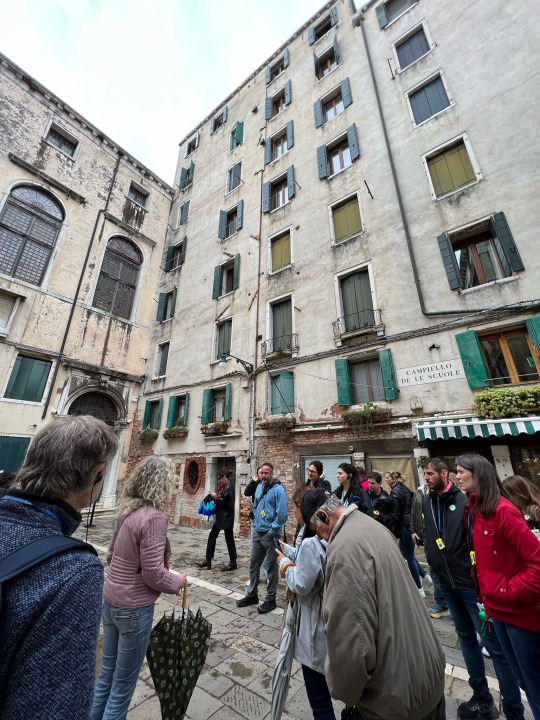
Our guide pointed out three of the unusually tall buildings that had five windows on the third floor rather than the usual four. These were concealed synagogues for the practice and study of their religion, hidden from hostile eyes. This was before the building of two splendid synagogues, jewels of the city, one Levantine and the other Spanish, right there in that tight square, as some in the community became more prosperous despite the restrictions. Incredibly ornate with marble and wood carved by master craftsmen, the synagogues were beautiful but also spoke of rivalry within the Ghetto, as each new wave of Jews from Germany or Spain or the Middle East, claimed their right to be there and made their livings, rising or falling in social status according to their means or wherewithal to succeed.
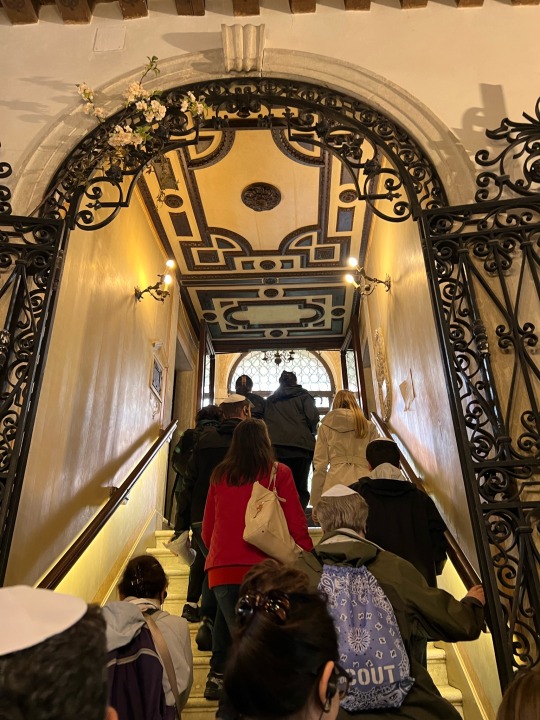
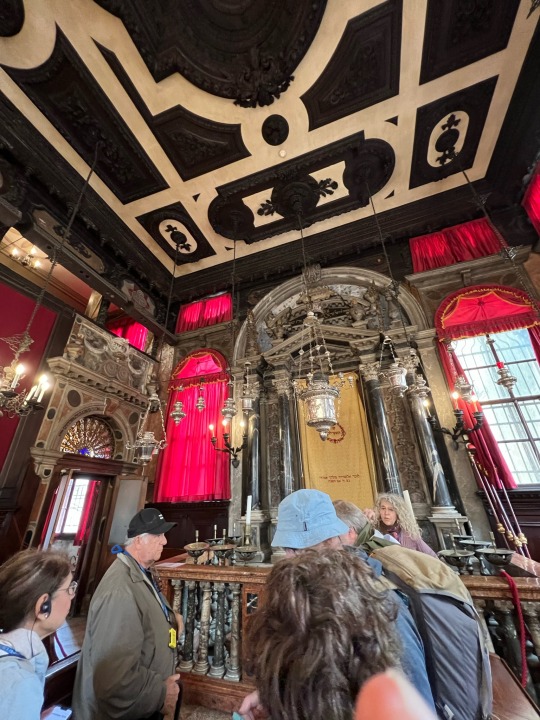

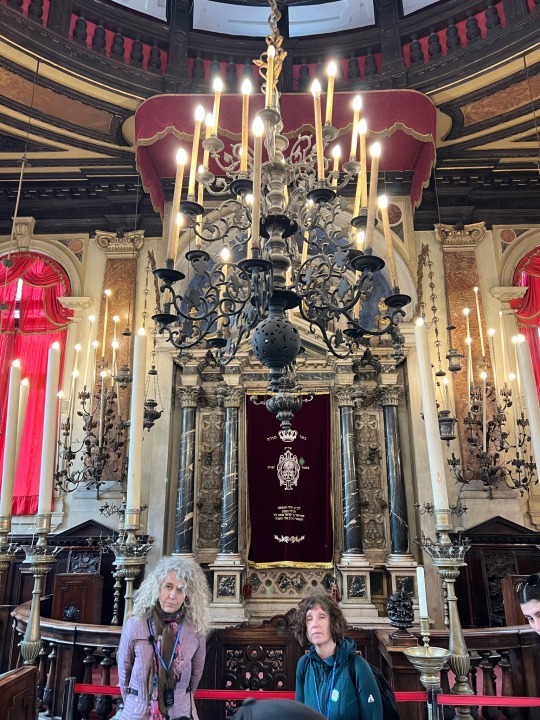


The early inhabitants would be locked into the area by 6pm every night, and allowed out at noon the next day, the men to ply one of the three trades they were allowed to follow: money lending (forbidden to Christians); trading second hand goods; and being doctors. What, no teachers, I asked? The synagogue is a school, our guide explained.
The most moving story was of the nursing home for sick elderly within the community who could not be moved when the WWII pograms arrived and others fled, or lived secret lives dispersed about the city.
Nazi’s came into the Ghetto and dragged elderly, sick women and men from their beds and transported them to a concentration camp where they soon died or were assassinated. Really, what threat did these old people pose that they could not be left to peacefully pass out of life?
Outside the old nursing home building, there are small bronze plaques worked into the cobbles of the square, each one a testament that these people lived and were cruelly taken before their time.

Later that evening we had had a joyful reunion with close friends from London who we coincidentally were overlapping with for an evening on our mutual holidays. How privileged we are to be able to move about so freely and enjoy our lives - something denied to so many, past and present, through no fault of their own.

Security guy had sat back down and phones were our combatants weapons of choice. Slashed jeans guys was still on his phone but not getting through, throwing comments across to security guy in his measured tones. Security guy was audibly more angry in his retorts as he stabbed out the numbers on the mobile. He got through and began to complain loudly about what was occurring. His right hand orchestrating his frustration.
The ferry, meanwhile, chugged and bumped into Punto Sabbioni, our temporary home port. Most people got up to leave, including the duelling pair, phones still to ears as if to put them away would signal surrender.
We shuffled off the ferry and the crowd quickly dispersed. We saw no more of security guy or the other.
Once the argument had begun, they had eyes for no one but each other, like new lovers having a first fight.
What had it all been about? We speculated as we walked the ten minutes back to camp. Slashed jeans guy had taken umbrage that security guy had been drinking either on or off duty but in uniform and armed, and had told him to remove his piece.
Security guy had been outraged to have been addressed and directed in this manner and the argument erupted, but yet he complied, knowing he was in the wrong.
If that was the case, then slashed jeans guy had a valid reason for his challenge, but his peremptory manner spoke more of class patrimony than community spirit and we were left feeling a little sorry for security guy and his lonely state, a ‘ghetto’ of his own making.
Madeleine
3 notes
·
View notes
Photo

Auschwitz Museum Remembers Gay Men Who Were Murdered in the Holocaust
The Auschwitz-Birkenau museum, located at the site of the former German Nazi concentration camp in Poland, recognized on Sunday a gay victim of the Holocaust.
“At least 77 men with pink triangles were imprisoned in Auschwitz & another 25 could have been initially arrested for their real or alleged homosexuality but had a different prisoner category. Some scholars speak of up to 140 prisoners persecuted for their sexual orientation,” the museum tweeted.
The tweet was posted on the birthday of a German man named Johann Mauler, who was born on April 24, 1897, and imprisoned at the concentration camp from November 12, 1941, until his murder on February 14, 1942. He was one of at least 77 people imprisoned at Auschwitz for the crime of homosexuality, the museum notes. Those imprisoned for homosexuality were forced to wear a pink triangle on their prison uniforms.
Every day, the museum posts images of several victims of the camp along with where they were from, their career, and when they were killed by the Nazi regime.
The account noted the museum's ‘Memory 4.0’ project, which is an online resource that explores the fate and persecutions of diverse groups of people deported to Auschwitz during World War II: political prisoners, Jews, Roma, Soviet POWs, Jehovah’s Witnesses, and queer people.
The portal includes resources such as educator guides that help accurately discuss the course of history during one of the darkest periods in the world.
More than one million people were killed at Auschwitz, most of them Jewish.
About 6 million Jews were murdered in the Holocaust, according to the United States Holocaust Memorial Museum. The institution reports that hundreds, maybe even thousands, of queer people were killed.
Read More | https://www.advocate.com/news/auschwitz-memorial-highlights-gays
4 notes
·
View notes
Text
A Long but Necessary Guide
Hello! I am Soup and this is my History, Anthropology, and Archeology sideblog! Welcome to my current passion, and here are a few things to make your stay a bit easier.
Tagging System
I try to tag in this order and with these details: decade, century/millennium, era/age, continent, region, country, culture, medium, misc.
Example: for a picture of a museum's embroidered Irish wedding dress worn at a lesbian wedding from 1837, I might tag it like this: 1830s, 19th century, Regency, Victorian, Europe, Western Europe, Ireland, Celtic, Exhibit, Embroidery, Queer History, Wedding, Veiled (usually in this order but most likely in any order. I will list multiple places, labels, decades, centuries, and ages/eras as I feel necessary. I will also omit tags if necessary/if no plausible info can be found).
Places are stated as nouns and cultures are stated as adjectives. Example: America not American, but Jewish or Nubian not Jews or Nubia.
Countercultures, societal generas, and established aesthetics count as cultures lmao. (Pirates, Bollywood, Punk, Cottagecore, Cavalier, Goth, Greek Revival, Hanfu, Rococo, Pop Culture, Grunge, Disco, etc.)
Miscellaneous tags so I don't forget:
Body Art and Tattoos
Bags and Belts
Charms and Amulets
Embroidery
Hair
Hats
Jewelry
Makeup
Pins and Patches
Socks and Shoes
Underwear
Veiled
Weapons
Armor
Ceremonial or Religious
Children
Folk Regalia
Momento Mori
Mourning
Uniform
Wedding
Black History
Disabled History
Indigenous History
Islamic History
Maritime History
Queer History
Anthropology
Archeology
Cosplay
Filmography
Fine Art
High Fashion
Iconography
Theater
Activism
Art Reference
Fantasy (for costumes)
Favorites
Fiction (for fan art or similar)
Meme
Not Clothing (for posts I couldn't resist)
Shopping (for posts with links to purchase items)
Dating Method
This is very important as things maybe get confusing.
This blog will primarily use the Holocene Calendar, in which the current year is 12,023 HE and the Human Era began at the building of the oldest known structure on Earth. The equation is (10,000 + current year) - (date + current year) = Human Era year. So if it's 2023 CE and the object is from 494 BCE, the object is now from 9506 HE.
All CE (Common Era, formally written as AD, the most recent 2000ish years) dates will be referred to by traditional methods and not tagged with a corresponding millennium to save myself the headache: 18th century, 1900s etc . HOWEVER, all BCE dates (Before Common Era, formally written as BC and with numbers going maddeningly backwards) will be instead portrayed by Human Era dates only. Luckily this will only be a problem from the Mesolithic Era and back so I'm not terribly worried about causing confusion.
Example: a picture of an exhibit of a bone necklace from North Italy dated from 3300 BCE might be tagged like this: 5320s, 54th century, 6th millennium, Neolithic, Chalcolithic, Bronze Age, Europe, Southern Europe, Western Europe, Italy, Alps, Exhibit, Archeology, Jewelry. Again, I overlap labels, eras, and regions as I feel necessary.
It seems confusing at first but it actually makes reading history a whole lot easier; rather than everything from before a certain Nazarene being squished together in a confusing hodgepodge of jumbled backwards dates, we now have a clear context of just how long ago an object is from as well as a clear linear view of history. Which of course leads to better appreciation.
Traditional Eras in Human Era Context:
Paleolithic: 2.5 million years PreHE - 0 HE
Mesolithic: 0 HE - 2000 HE
Neolithic: 2000 HE - 5000 HE
Bronze Age: 5000 HE - 8800 HE
Iron Age: 8800 HE - 9500 HE
Classical Age: 9500 HE - 10500 HE
Middle Ages: 10500 HE - 11500 HE
Modern Age: 11500 HE - Present
FINALY: Please note that this is a work in progress, and I only work on it when I want to, so not everything is tagged yet qwq.
Thank you! And enjoy this blog!
3 notes
·
View notes
Text
Prague - Day 3
Another beautiful day in The City of a Thousand Spires! The day started with us traveling up to the other side of the river to visit the Prague Palace and surrounding monastery. We got to see some beautiful vistas and views of the whole city, as well as get to see some of the old areas of the town that have been walked by various politicians & royalty. We also got to see the area known as “The Gate to Hell” where a prince’s mother once allegedly was dragged to hell because she cursed out the Almighty when her driver was trying to pray. This is of course a legend, but it is a GOOD one. We also got to see members of the castle band, on their way to preform.
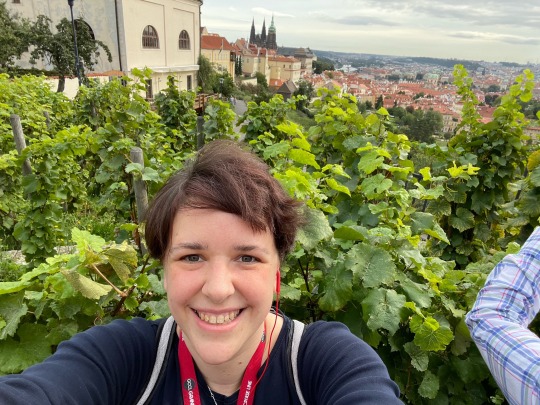
We then made our way to the castle, and especially the Viritus Cathedral. The castle has its own set of guards, their uniforms designed by Theodore Pištêk, the Oscar winning costume creator for the movie “Amadeus”, and the choreography of the changing of the guard developed by Miloš Forman, who choreographed “Hair”. We did not get to go into the castle but we did get to go inside the cathedral. The stained glass was utterly gorgeous (as to be expected) and it was so cool to see how the cathedral has grown and developed through the ages. The gargoyles were pretty cool to see as well, even more fun than the ones I used to see outside the National Cathedral in DC.



We took the longer way through towards lunch, getting to walk through some beautiful gardens, including one with a koi pond in the middle. There were peacocks walking around the gardens, who were very pleased to be appreciated by passerby’s. After a filling lunch, we made our way towards the Charles Bridge, and in doing so passed by the John Lennon wall. I had only read about this piece of artwork but seeing it in person was seriously really cool. Especially to see all the different messages and artwork from the years layered on top creating a unique mosaic of statements of goodwill and love. Mom of course had to get a picture of me in front of it; its only fair since I’ve loved The Beatles since I was in the womb.
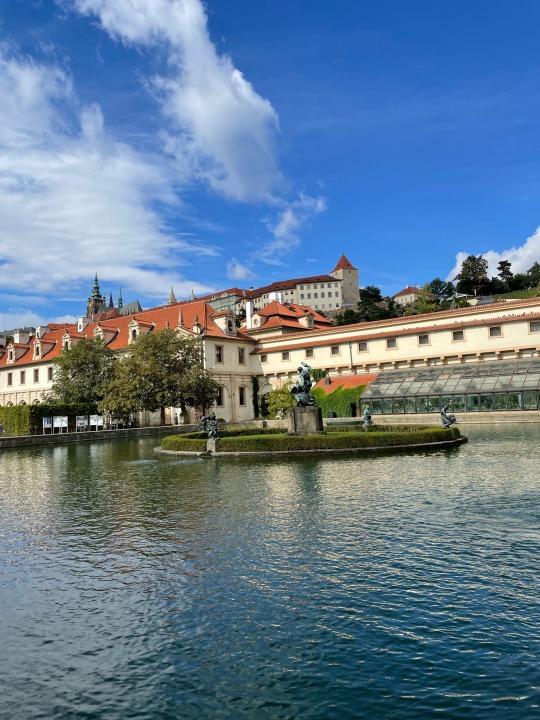
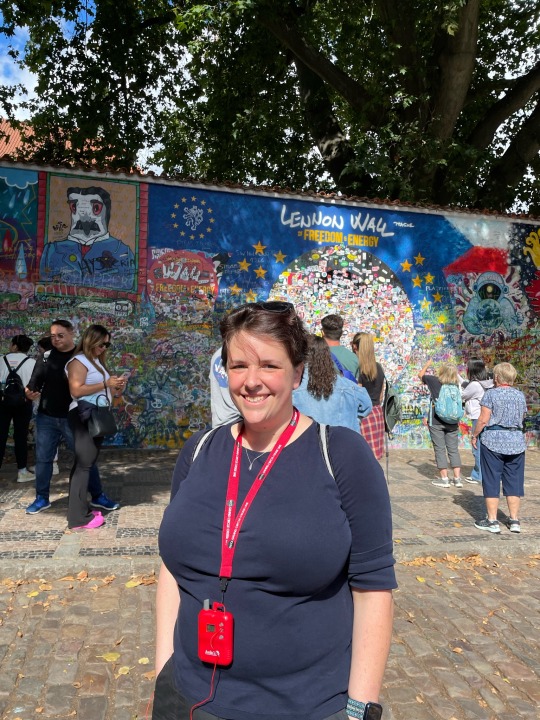
The afternoon saw us on a tour of the Jewish Quarter of the city. I was very excited to see this area of the town because I had read stories of the strength of the Czech people during WWII and I also wanted to see some of the synagogues of the area. My mother & I are not Jewish but some of the people we have loved the best are Jewish & we have been honored to witness some of the Jewish traditions throughout the years. The focus of the tour spoke on the struggles of the Jewish community prior to WWII and during it, and then the effects of the rise of communism in the area. Turns out that due to the collection of interconnected synagogues in the city, along with the memorial stones (called “Stumbling Stones”) along the streets of the quarter, make Prague the location of the largest Jewish museum in the world & the largest Holocaust Memorial in the world. We got to visit some gorgeous synagogues, two which are still active & holding routine prayer services. The highlight was getting to visit the Old-New Synagogue, the oldest synagogue in all of Central Europe. In one of the the non-active synagogues, it was created into a memorial of the all of the names of Jews lost in the Holocaust that lived in the area previously known as Czechoslovakia, which we found out also contained the names of the grandparents of Madeline Albright. Upstairs was a collection of children’s artwork that have been preserved from art therapy sessions given to the children of the Terezin ghetto, as a way for the children to process the changes in the world around them and find hope even in what could be construed as ultimate darkness. As someone who has used art as a way to help her own clients heal and find meaning in their complicated world, seeing all the beautiful pieces of artwork just reminded me how powerful visual media can be for someone so young.
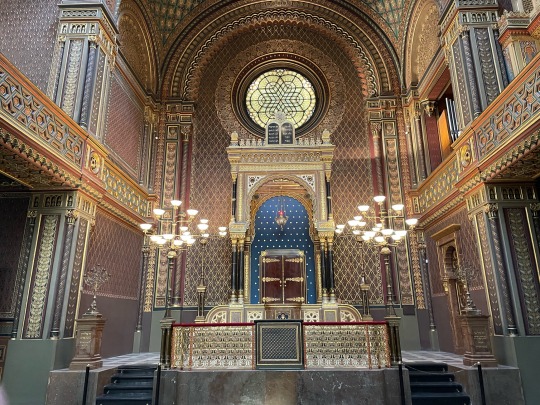
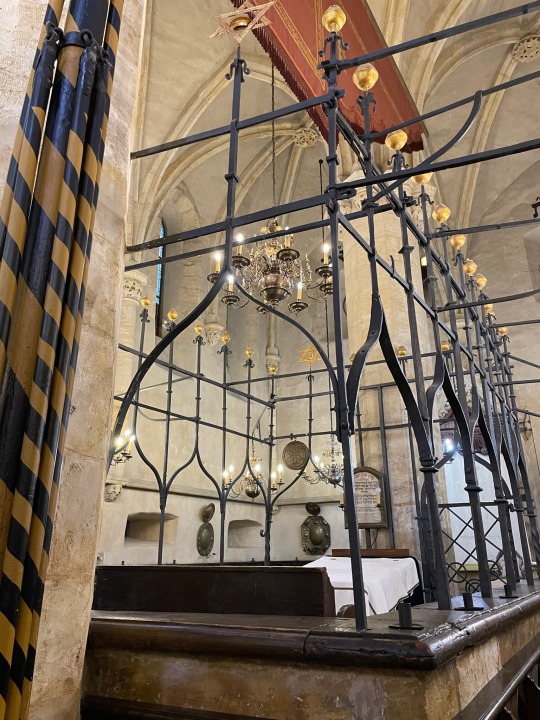
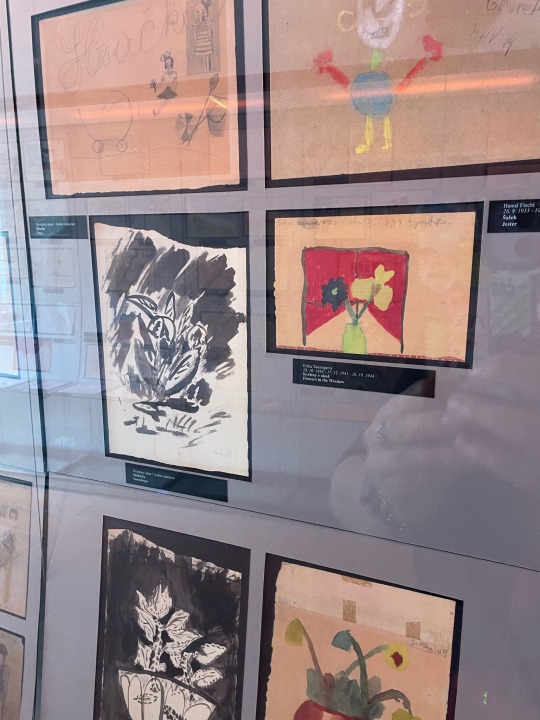
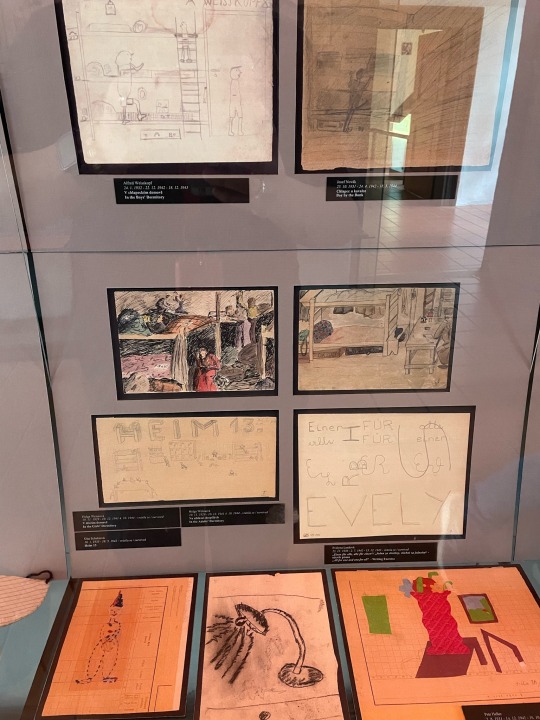
After the tour Mom & I made our way back to the hotel and later out to grab some pizza at a nearby restaurant with our companions on the Jewish Quarter tour. A long day, but so incredibly interesting.
Tomorrow we head to Česky Krumlov, which I hear will be absolutely gorgeous. So I say farewell for now & I will report back again tomorrow evening!
Lowrs💜
0 notes
Text

Peter Howson: A Brush with Evil: Holocaust Crowd Scene II. This monumental canvas, a visceral and haunting representation of the horror and brutality of the Nazi concentration camps, depicts Jewish prisoners in various attitudes of grief, suffering and lamentation.
This painting graphically depicts the horror and brutality of the Nazi concentration camps with the crowd of Jewish prisoners, stripped of their own clothing and dressed in striped camp uniforms, depicted in attitudes of grief, suffering and lamentation. They are flanked by two thuggish Nazi guards wearing swastika armbands, one making a Nazi salute and the other pointing inward to focus attention on a prisoner prominently displaying the yellow badge with the Star of David that Jews were forced to wear in Nazi-occupied Europe, used here symbolically to indicate martyrdom.
Peter Howson, Holocaust Crowd Scene II, 2011 | Ben Uri Gallery and Museum
Holocaust Crowd Scene II | Art UK
0 notes
Text
Guest Review: The Girl Who Escaped from Auschwitz by Ellie Midwood
The Girl Who Escaped from Auschwitz by Ellie Midwood is a fantastic historical novel. It is timely considering the Jewish holidays are just around the corner. It shows how survival was of the utmost importance.
“Most of it is true. I tried sticking to as much historical fact as I possibly could dig out from all the sources available, including the Auschwitz Museum itself. Mala’s and Edek’s locks of hair are still on display there and I urge all of my readers who shall ever visit the museum to ask the curators to see them and to hear the couple’s incredible true story from the museum historians themselves. But everything starting with Mala’s and Edek’s life stories to the timeline of events in the camp, their relationship with other inmates and the SS, the development of their personal relationship and the escape itself—it’s all based on fact.”
Mala Zimetbaum was an interpreter for the SS. But unlike the Kapos she uses her position to save as many lives as she can, from smuggling scraps of bread to those desperate with hunger, to warning those straight off the trains what to say to avoid Mengele’s clutches.
“I first began noticing Mala’s name being mentioned by different survivors and historians while researching the Holocaust for my other books. And the more I saw her name in different sources, the more I began wondering why so many people remembered her as someone truly special, someone who either helped them directly or indirectly, through her own example that resisting inside the death camp was not only possible but sometimes necessary. Soon, I concentrated my research solely on her and discovered a person of such incredible strength and compassion, her story simply begged to be told to a wider audience. And of course, Mala’s story wouldn’t be complete without Edek—her love and her fellow conspirator. That’s pretty much how the plot for The Girl Who Escaped from Auschwitz was born.”
“Mala knew how to navigate the complex Auschwitz hierarchy to gain trust of several high-ranking SS officials and make use of their favoritism to aid as many people as possible. She was a selfless and compassionate person, ready to part with her own last shirt to help those in need, but at the same time she was incredibly strong and defiant, her rebellious nature reaching its apogee when she slapped an SS official in one of the chapters (the events based on real fact mentioned by several Auschwitz survivors, much to my own astonishment!). Mala was a fighter and a brilliant woman who was taken from the world too soon, but she certainly left a legacy after herself and I couldn’t be happier that more and more people are learning about this incredible woman.”
Edek Galinski is known as inmate 531, is a camp veteran and a Polish political prisoner. Though he looks like everyone else, with a shaved head and striped uniform, he’s a fighter in the underground Resistance. And he has an escape plan. Edward makes Mala believe in the impossible. That despite being surrounded by electric wire, machine guns topping endless watchtowers and searchlights roaming the ground, they will leave this death camp.
“Edek is a survivor. He was among the first inmates transported to Auschwitz, which made him a “camp veteran” by the time he met Mala and began plotting their escape. In Auschwitz, where most inmates died within weeks after their arrival (if they weren’t gassed upon arrival), avoiding death for so long was something truly remarkable. Throughout the years Edek carefully navigated the camp establishing a trusting relationship with the sympathetic SS guard Lubusch (who later aided his escape) and other inmates who came to his aid, just like he came to theirs in time of need. Edek was very well-liked by other inmates, approachable, always in good humor and very savvy. He wasn’t afraid to take risks and had a defiant streak in him—a trait which, no doubt, brought him and Mala closer together as she was a rebel herself.”
This book will take readers on an emotional rollercoaster ride. They will laugh, cry, have hope, and then disappointment as they take the journey with these unforgettable heroes.
0 notes
Text
3. Memorial de la Shoah
The Memorial de la Shoah was opened on January 5th, 2005, which aligned with the International Holocaust Remembrance Day and the 60th anniversary of the freeing of the Jews in the Auschwitz concentration camp. There was a higher abundance of Jews in the area of the memorial at the beginning of World War II, and this memorial was created to remember those who were lost during this horrifying time in history.
This museum was very clear in its layout, with a permanent exhibit in the basement that flowed in a timeline of the events leading to the Holocaust and the actual Holocaust itself. There were even train tracks leading into the next room in the exhibit to signify the deportation of Jews to concentration camps, which the next room specifically focused on. After the timeline exhibit, there was another small area that showed some of the files they had to identify Jews in France, as well as one of the wooden doors of a camp. At the entrance and exit of the museum, we went past all the names of those who died at concentration camps which was really impactful to exemplify the immense number of people that were a part of the camps. My perspective of the names also changed as I saw them a second time once I learned more details about the terrible things the Jews had to experience.
As for the experience in the main exhibit, most of the it consisted of reading short descriptions about items that were saved from the Holocaust, reading timelines, or watching short videos. This was not a very interactive exhibit, so we were unable to touch pieces and there were not interactive touchscreens either.
Throughout the memorial, it was made very clear that the Jews were treated terribly during the reign of Hitler and World War II. There was discrimination everywhere, not just in Germany against Jews. In Paris, there were certificates handed out to people that were not Jewish. The unfair treatment of Jews developed over time, where they were first identified and forced to wear the star of David, soon they were not allowed to go into certain stores, books were burned, they were forced to move to ghettos, and eventually they were sent to concentration camps. Hitler taught Nazi ideology to his followers, which was centralized on a severe hatred toward Jews. There were even children’s books that taught antisemitism. I thought it was very interesting that they displayed one of the uniforms that the Jews had to wear and also a cloth that was made from the women prisoner’s hair - which was very shocking to me.
Some lessons implicated from this exhibit show that treatment of people who differ from us is never justified, especially in the inhumane way that Hitler treated Jews. People must be treated equitably, allowing everyone to receive the same opportunities. This is very relevant even today, with much discrimination still occurring against different races. We should embrace the diversity within us and learn about different cultures and religions. Being more educated in these areas allows us to see different perspectives and creates better group dynamics in the workplace and friendships because people will have more dynamic ideas. The world would be boring if everyone were cookie cutter copies of each other, and we need to learn to appreciate the rich diversity that is present in our world.
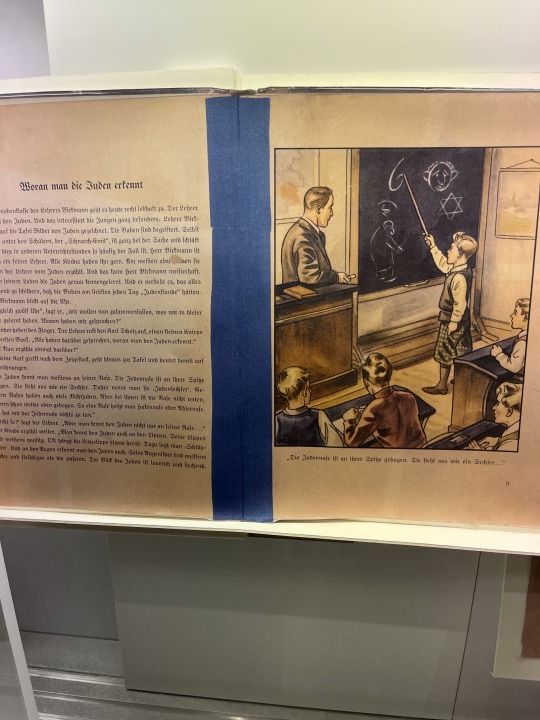

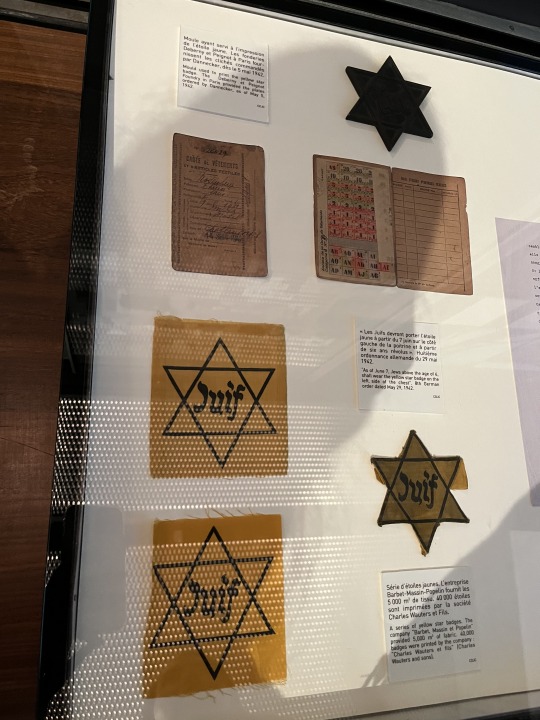
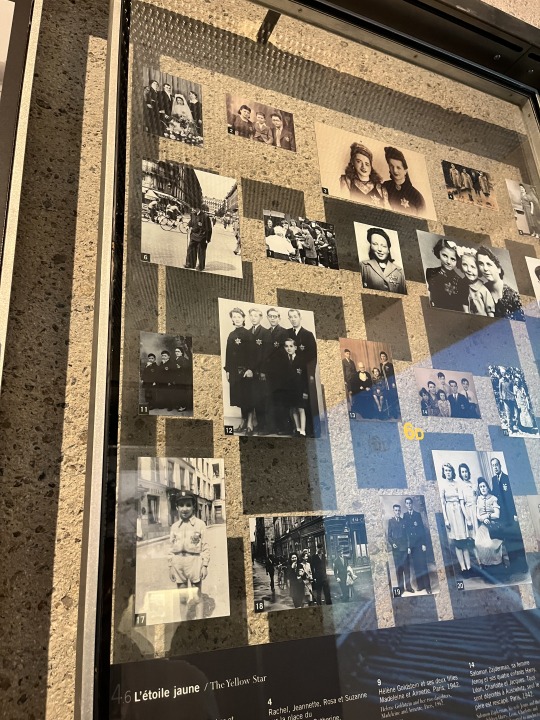
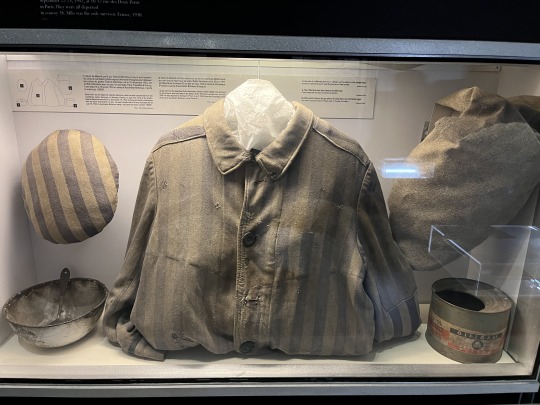
0 notes
Photo
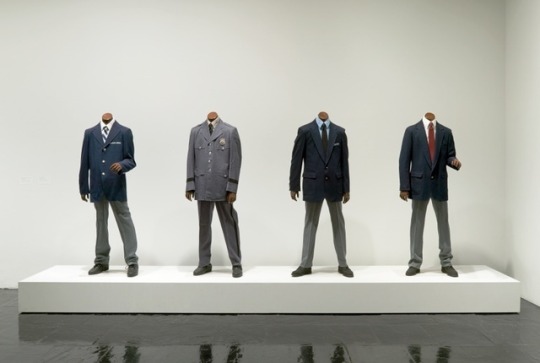
Guarded View, Fred Wilson
#Fred Wilson#1991#Jewish Museum uniform#Metropolitan Museum of Art uniform#Whitney Museum of American Art uniform#Museum of Modern Art uniform#sculpture
1 note
·
View note
Photo

#DYK: June 20th is #AmericanEagleDay? From the JMM Collections: U.S. Army insignia worn by Edna Jontiff, 1943-1945. JMM 1992.155.5.

Edna served aboard the hospital ships Acadia and Larkspur as a 1st lieutenant in the US Army Nurse Corps. during World War II. Here she is in uniform, 1945. JMM 1992.124.007.
1 note
·
View note